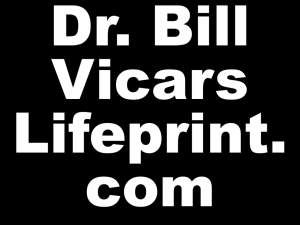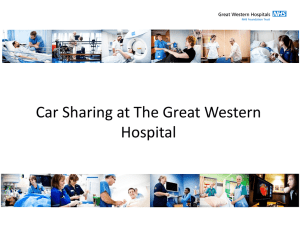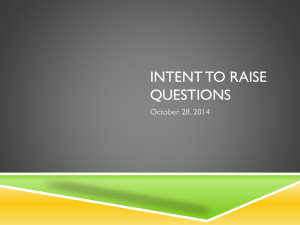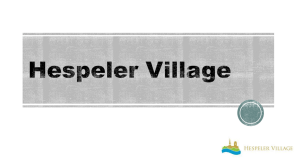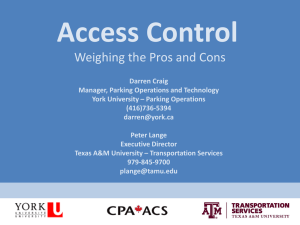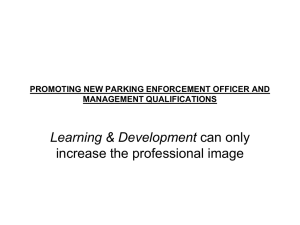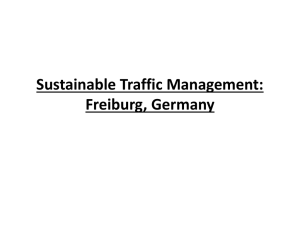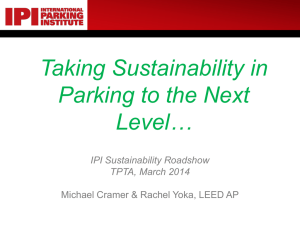Rick Williams - Sylvan Highlands Neighborhood Association
advertisement
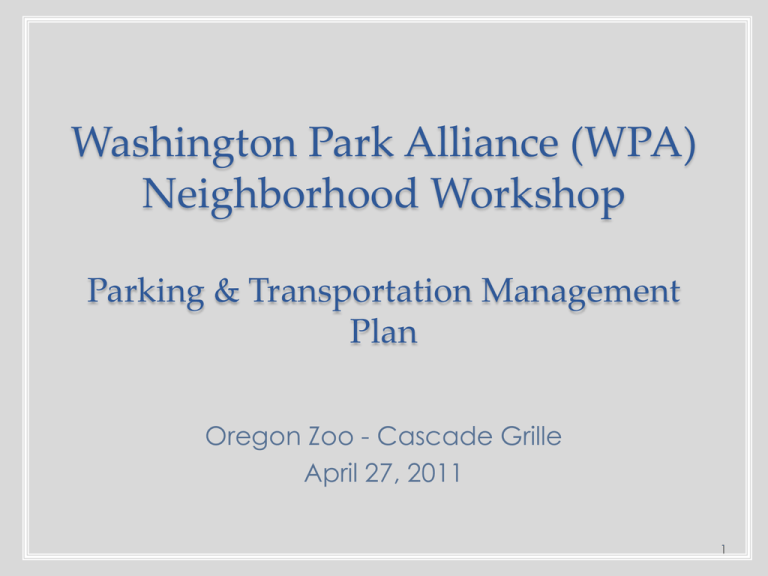
Washington Park Alliance (WPA) Neighborhood Workshop Parking & Transportation Management Plan Oregon Zoo - Cascade Grille April 27, 2011 1 Today’s Desired Outcomes • To provide Neighborhood representatives an overview of the Parking and Transportation Management Plan process. • To hear input, concerns and ideas from the Neighborhoods regarding parking and transportation management for Washington Park. • To utilize that input in strategy and program planning. • To schedule a report back to present strategy and program recommendations. 2 RWC – Kittelson Scope • Stakeholder interviews/fact finding (COMPLETED & ONGOING) • Development of Guiding Themes and Principles (COMPLETED) • Facilitation of WPA Directors/PLOC work sessions (ONGOING) • Outreach to neighborhoods (UNDERWAY – MTG 1 TODAY) • Strategy Development (near, mid- and long-term implementation (INITIATED) • Plan completion (SEPT – DECEMBER 2011) 3 RWC – Kittelson – Anticipated Products • Supply management and operational systems ˗ How much parking is available now and can it be better managed? • Pricing strategies ˗ How much should it cost? • Developing new supply (type, cost and feasibility) ˗ Should we change how much we have? • Transportation Demand Management (TDM) Plan ˗ Are there options to reduce parking demand? • Communications and Marketing ˗ How do we communicate our changes and options? 4 What the Consultants Already Knew • Many efforts have preceded this study, need to find strategies that let us “pull the trigger” on change. • Need to work together, look at the entire park and take a holistic approach. • There are real problems that affect customers, employees and residents. • Strategies/solutions need to be strategic, effective and diverse. 5 What We Heard DIRECTORS • Status quo needs to change • Better strategic coordination of access (parking & TDM) • Leverage MAX as a meaningful access resource • Create a true “campus” within the Park • Explore multiple solutions for a better Park • Address flaws in existing parking system – layout, roadways, signage, “quality of product.,” balance of access by mode, sustainability 6 What We Heard SYLVAN HIGHLANDS (Initial coffee mtg.) • Fairview/Skyline, Fairview/Knight: dangerous/blind intersections • Pedestrian safety issues – no sidewalks (need plan) • Need Kiss & Ride opportunities at LRT • Leverage MAX as a meaningful access resource • Neighborhood pass – use of Park lots • Parking issues in neighborhood (how to control?) 7 Key Themes & Principles COORDINATION • Centralize management of the parking and access system within the WPA . • Ensure all WPA partners are participating at the senior level. • Coordinate access strategies to minimize conflicts with adjacent uses • Clear systems for measuring and reporting success 8 Key Themes & Principles ACCESS • Recognize that parking in the Park is a finite resource and needs to be managed in a manner that reflects its value. • Access by non-auto modes needs to increase and be better encouraged and supported. 9 Key Themes & Principles ACCESS 10 Key Themes & Principles INTUITIVE & HIGH QUALITY • Provide for a world class visitor experience. • Make parking user-friendly – easy to access, easy to understand • All access is safe & secure • Centralized system of communication and program delivery (common brand) 11 Key Themes & Principles INTUITIVE & HIGH QUALITY 12 Key Themes & Principles MULTI-MODAL ACCESS • Manage parking as a tool to achieve successful attainment of goals for other modes (transit, bike, walk, carpool) • Optimize MAX 13 Key Themes & Principles SUSTAINABILITY • Parking and access management should contribute to the broader vision that values green area in the Park, reduces greenhouse gas emissions and contributes to the environmental well-being of the Park. • Parking and access management should be financially sustainable. 14 Key Themes & Principles SUSTAINABILITY 15 Next Steps • Work session today to hear from you • Take feedback, ideas, and suggestions and incorporate into strategy development • Work with you to schedule report back meeting 16
